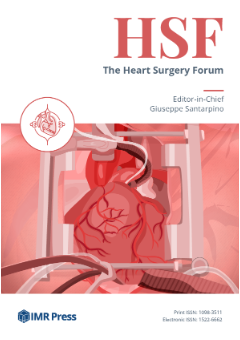Announcements
The Heart Surgery Forum (HSF) is published by IMR Press from Volume 28 Issue 9 (2025). Previous articles were published by another publisher under the CC-BY-NC licence, and they are hosted by IMR Press on imrpress.com as a courtesy and upon agreement.
Open Access
Article
Efficacy of Propafenone Hydrochloride in Preventing Postoperative Atrial Fibrillation after Coronary Artery Bypass Grafting
Nobuhisa Ito, Tadashi Tashiro, Noritsugu Morishige, Masaru Nishimi, Yoshio Hayashida, Kazuma Takeuchi, Noritoshi Minematsu, Go Kuwahara, Yuta Sukehiro
Heart Surg. Forum 2010, 13(4),
223–227;
https://doi.org/10.1532/HSF98.20091173
Published:
18 August 2010
Abstract
Background:Atrial fibrillation (AF) is one of the most common complications after coronary artery bypass grafting (CABG), and the incidence of postoperative AF (PAF) is estimated to range from 10% to 40%. PAF is a serious complication that is related to unstable hemodynamics, development of embolisms, patient discomfort, and increased medical costs associated with the prolongation of hospital stay. Sometimes, immediate attention is also necessary. In this study, we assessed the efficacy of treatment with the antiarrhythmic drug propafenone hydrochloride, which was administered in the early postoperative period, in preventing the development of PAF, and we attempted to identify risk factors for PAF.Materials and Methods:The subjects were 78 patients who underwent isolated off-pump CABG between July 2007 and October 2008. We conducted the study by dividing the patients into 2 groups, a group of 26 patients who received propafenone hydrochloride (P group) and a control group of 52 patients who did not receive this drug (C group). The patients in the P group were given propafenone hydrochloride (150-450 mg/day orally) for 10 days, starting on the day after surgery, and were observed for the development of AF by means of continuous 12-lead electrocardiographic monitoring. Development of AF was defined as AF that lasted ?30 minutes or as supraventricular arrhythmia that required new treatment even though it did not persist for 30 minutes.Results:The background factors of the patients in the P and C groups were similar. The operation times and the numbers of distal anastomoses in the 2 groups were similar, and there were no particular differences between the 2 groups with respect to postoperative factors. The incidence of PAF was 35% in the C group and significantly lower in the P group (12%,P= .0337). Moreover, multiple logistic regression analysis showed that propafenone hydrochloride was the sole factor that prevented the development of PAF (odds ratio, 0.207; 95% confidence interval, 0.053-0.804;P= .0229).Conclusion:Cases must be carefully considered before administering propafenone hydrochloride, but the results of this study indicate that propafenone hydrochloride may prevent the development of PAF.

